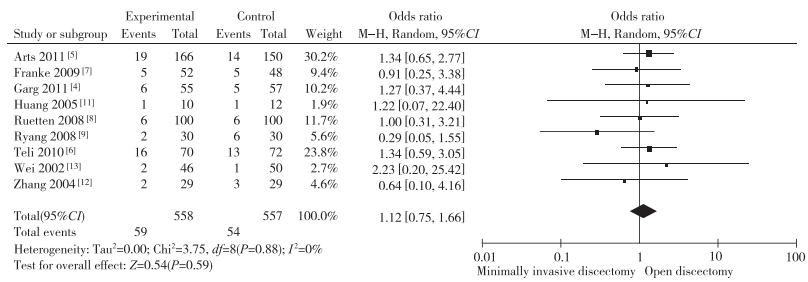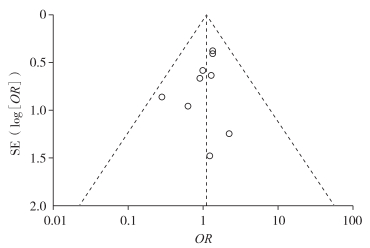2. 北京市仁和医院骨科, 北京 102600
2. Department of Orthopaedics, Beijing Renhe Hospital, Beijing 102600, China
开放椎间盘切除术是治疗腰椎椎间盘突出症(LDH)的经典术式,但其具有创伤较大、软组织损伤较重的不足[1]。微创椎间盘切除术是近几年研究的热点,理论上其无需大范围的软组织切开,术中出血少、术后疼痛较轻,但其临床疗效一直存在争议[2]。本研究通过对国内外文献搜索,对微创与开放椎间盘切除术治疗LDH的临床疗效进行Meta分析,比较两种术式的疗效,为临床治疗LDH术式的选择提供依据。
1 资料与方法 1.1 文献选择的标准国内外1990年4月-2015年4月发表的关于微创和开放椎间盘切除治疗LDH的前瞻性随机对照研究(RCT)。研究对象国籍和性别不限,均伴有腰部及下肢症状,体格检查、辅助检查诊断为LDH,并符合腰椎手术指征。术后随访时间> 6个月。微创手术(minimally invasive discectomy,MID)包括微创管状椎间盘切除术(tubular discectomy,TD)、显微镜辅助经皮髓核切除术(microscope-assisted percutaneous nucleotomy,MAPN)、显微内窥镜椎间盘切除术(microendoscopic discectomy,MED)、经皮内窥镜下椎间盘切除术(percutaneous endoscopic lumbar discectomy,PELD)、微创穿刺椎间盘切除术(minimal access trocar microdiscectomy,MATMD)。开放手术(open discectomy,OD)包括传统开放椎间盘切除术(conventional open discectomy,COD)和传统微创椎间盘切除术(conventional microdiscectomy,CMD)。其中PELD包括经椎间孔和经椎板间两种入路。排除标准:①研究未提供规范的临床数据;②腰椎椎管狭窄、腰椎间盘二次手术、腰椎骨折、马尾综合征、椎管内占位、腰椎肿瘤等其他疾病;③重复研究。
1.2 文献检索使用数据库和网上资源检索文献信息,再辅以手工检索。检索数据库包括PubMed数据库、Cochrane Controlled Clinical Trials Register数据库、EMbase数据库、中国知网数据库、万方数据库、中国生物医学文献数据库、Google学术。中文检索词选择“椎间盘突出症”“微创”“开放”,英文检索词选择“minimally invasive discectomy”“open discectomy”“mircodiscectomy”,对“tubular discectomy”“endoscopic interlaminar discectomy”“endoscopic transforaminal discectomy”“minimal access trocar microdiscectomy”“microendoscopic discectomy”“microscope-assisted percutaneous nucleotomy”进行单独检索。
1.3 质量评价标准由多名研究员分别独立浏览阅读所有检出文献的题目、摘要,严格按照制定的纳入和排除标准进行筛选,对于考虑纳入的文献阅读全文后进行进一步筛选。文献筛选如发生分歧则交由第三方裁决。采用Jadad量表(又称牛津评分系统)对文献质量进行评价[3],1~3分视为低质量,4~5分视为高质量。如量表评分为低质量研究则在提取数据时舍弃。
1.4 数据的提取和分析主要提取的数据包括病例的基本特征(病例数、年龄、性别比例)、手术相关指标(手术时间、术中出血量、住院时间)、随访时间、术后并发症(感染、复发)、功能改善。功能改善主要提取患者术后1~2年视觉模拟量表评分(VAS)、Oswestry功能障碍指数(ODI),采用VAS评分评价患者的腰部、下肢痛改善情况。VAS评分统一为10分制,如文献VAS评分为100分制则换算为10分制。
数据的合并采用Review Manager 5.3软件(Cochrane协作网提供),并进行Meta分析。首先判定临床数据的异质性,如存在异质性(P < 0.10,I2 > 50%)需分析产生异质性的原因,若采用敏感性分析无法消除其异质性,一般使用随机效应模型分析。如无异质性(P≥0.1,I2≤50%)则采用固定效应模型分析。计量资料计算均差(mean difference,MD)和95%置信区间(confidence interval,CI),计数资料计算优势比(odds ratio,OR)和95%CI。若Meta分析显示两种手术方式在相关指标上的差异存在统计学意义,则使用漏斗图分析是否存在发表偏倚。应用Gradepro软件对每项研究指标进行证据分级。
2 结果 2.1 文献检索结果初步检索到相关文献702篇,排除不符合标准的文献628篇以及重复收录的57篇,获得文献17篇;阅读全文进一步筛查除去随访时间 < 6个月3篇,非RCT研究2篇,综述1篇,重复研究1篇,最终纳入Meta分析的文献为10篇[4-13](表 1)。文献质量评价均为高质量研究。
|
|
表 1 纳入研究的基本特征 Table 1 Characteristics of included studies |
入选的文献中8篇[4-6, 9-13]报道了两种手术方式的手术时间,其中1篇文献[12]因未采用x±s模式而未被统计在内。分析显示各组研究具有统计学异质性(P < 0.01,I2=97%),采用随机效应模型,计量资料采用MD。两种手术方式平均手术时间之间差异无统计学意义[P=0.64,MD=4.79,95%CI(-15.05,24.63)](图 1)。Grade分级为中级质量。

|
图 1 2种手术方式手术时间的Meta分析森林图 Figure 1 Meta analysis forest map of operation time for minimally invasive or open surgery |
入选的文献中6篇[4, 9-13]报道了两种手术方式的术中出血量。分析显示各组研究具有统计学异质性(P < 0.01,I2=98%),采用随机效应模型,计量资料采用MD。两种手术方式平均术中出血量之间差异有统计学意义[P=0.02,MD=-140.98,95%CI(-261.53,-20.43)](图 2),微创组术中出血量明显小于开放组术中出血量。Grade分级为中级质量。

|
图 2 2种手术方式术中出血量的Meta分析森林图 Figure 2 Meta analysis forest map of intraoperative blood loss during minimally invasive or open surgery |
入选的文献中7篇[4-6, 9, 11-13]报道了两种手术方式的住院时间,其中1篇[12]未采用标准的x±s方式因此未被评价。分析显示各组研究具有统计学异质性(P < 0.01,I2=99%),采用随机效应模型,计量资料采用MD。两种手术方式住院时间之间差异有统计学意义[P < 0.05,MD=-3.29,95%CI(-5.24,-1.35)](图 3),微创组住院时间明显短于开放组。Grade分级为中级质量。

|
图 3 2种手术方式住院时间的Meta分析森林图 Figure 3 Meta analysis forest map of hospital stay for minimally invasive or open surgery |
入选的文献中6篇[5-6, 8-11]报道了两种手术方式的术后下肢疼痛缓解情况。分析显示各组研究无统计学异质性(P=0.10,I2=46%),采用固定效应模型分析,计量资料采用MD。两种手术方式术后下肢疼痛之间差异无统计学意义[P=0.12,MD=0.10,95%CI(-0.02,0.22)](图 4)。Grade分级为低质量。

|
图 4 2种手术方式术后下肢疼痛的Meta分析森林图 Figure 4 Meta analysis forest map of postoperative lower limb pain after minimally invasive or open surgery |
入选的文献中7篇[4-10]报道了两种手术方式的术后ODI情况。分析显示各组研究无统计学异质性(P=0.26,I2=22%),采用固定效应模型分析,计量资料采用MD。两种手术方式术后ODI之间差异无统计学意义[P=0.65,MD=0.23,95%CI(-0.76,1.22)](图 5)。Grade分级为低质量。

|
图 5 2种手术方式术后ODI的Meta分析森林图 Figure 5 Meta analysis forest map of ODI after minimally invasive or open surgery |
入选的文献中4篇[5-6, 8, 10]报道了两种手术方式的术后腰部疼痛情况。分析显示各组研究具有统计学异质性(P < 0.01,I2=97%),采用随机效应模型分析,计量资料采用MD。两种手术方式术后腰部疼痛之间差异无统计学意义[P=0.55,MD=0.28,95%CI(-0.64,1.21)](图 6)。Grade分级为低质量。

|
图 6 2种手术方式术后腰部痛的Meta分析森林图 Figure 6 Meta analysis forest map of postoperative lumbar pain after minimally invasive or open surgery |
入选的文献中9篇[4-9, 11-13]报道了两种手术方式的术后并发症情况。分析显示各组研究无统计学异质性(P=0.88,I2=0%),采用固定效应模型分析,计数资料采用OR。两种手术方式术后并发症之间差异无统计学意义[P=0.59,OR=1.12,95%CI(0.75,1.66](图 7)。Grade分级为低质量。

|
图 7 2种手术方式术后并发症的Meta分析森林图 Figure 7 Meta analysis forest map of postoperative complications after minimally invasive or open surgery |
入选的文献中4篇[4-6, 11]报道了两种手术方式的术后感染情况。分析显示各组研究无统计学异质性(P=0.97,I2=0%),采用固定效应模型分析,计数资料采用OR。两种手术方式术后感染之间差异有统计学意义[P=0.04,OR=0.24,95%CI(0.06,0.96)](图 8)。Grade分级为低质量。

|
图 8 2种手术方式术后感染的Meta分析森林图 Figure 8 Meta analysis forest map of postoperative infection after minimally invasive or open surgery |
入选的文献中6篇[4-9]报道了两种手术方式的术后复发情况。分析显示各组研究无统计学异质性(P=0.30,I2=17%),采用固定效应模型分析,计数资料采用OR。两种手术方式术后复发之间差异无统计学意义[P=0.27,OR=1.35,95%CI(0.80,2.29)](图 9)。Grade分级为中级质量。

|
图 9 2种手术方式术后复发的Meta分析森林图 Figure 9 Meta analysis forest map of postoperative recurrence after minimally invasive or open surgery |
本文纳入研究文献10篇,以术后并发症为例分析发表偏倚,漏斗图显示大部分研究处于“倒漏斗”的上部而基底部研究较少,且左右大致对称,提示发表偏倚不明显(图 10)。

|
图 10 10篇文献术后并发症发表偏倚的漏斗图 Figure 10 Funnel plot analysis of published bias about postoperative complications in 10 studies |
1993年,Mayer等[14]首先应用内窥镜治疗LDH,LDH的微创治疗逐渐兴起。此后又出现了MED、PELD等多种手术方式,但微创和开放手术的疗效一直是争论的焦点[15-17]。因此,有必要综合国内外文献进行Meta分析,为临床提供循证医学证据。Grade系统将证据分为四级:高、中、低和极低,其中无严重缺陷的RCT为高质量证据,如果RCT存在可能降低证据质量的因素则为中等质量,无突出优势或有严重缺陷的观察性研究属于低质量证据[18]。本研究选取的文献均为RCT,但存在降低证据质量的因素。常见的降低证据质量的因素包括研究的局限性、结果不一致、间接证据、精确度不够、发表偏倚。本研究结果中手术时间、术中出血量、住院时间、复发为中等质量证据,术后并发症(感染)、术后下肢痛、腰部痛、ODI为低质量证据。
本研究结果提示微创手术在住院时间、术中出血量及术后感染方面均优于开放手术,而手术时间、术后并发症、术后恢复(术后下肢痛、腰部痛、ODI)与开放手术无明显差异。文献报道椎间盘切除术后复发率为3.5%~20.0%[6, 19],因此本研究将术后并发症中的复发单独分析,结果发现微创手术与开放手术无明显差异。本研究入选文献随访时间最短10个月,可认为微创手术与开放手术在远期疗效方面无明显差异。
本研究的优势在于所有纳入的研究均为RCT,且纳入的文献均为高质量的国内外文献,漏斗图分析显示研究结果偏倚不明显,因此该研究结果提供了较为可靠的循证医学证据。但本研究也存在一定的不足。在不同的研究组之间手术者的手术经验不相同可能导致不同的手术时间、术中出血量及术后并发症,如果术者的微创手术经验较多而开放手术经验较少,手术结果可能偏向于微创,反之则有可能偏向于开放手术。此外,本研究对不同的微创手术、开放手术方式均认为采取相似的技术,精确度不够;部分指标纳入文献相对较少。本研究结果尚需大样本、前瞻性、多中心、随机对照临床研究进一步证实。
| [1] | Telfeian AE, Jasper GP, Francisco GM. Transforaminal endoscopic treatment of lumbar radiculopathy after in strumented lumbar spine fusion[J]. Pain Physician, 2015, 18(2): 179–184. |
| [2] | Payer M. "Minimally invasive" lumbar spine surgery:a critical review[J]. Acta Neurochir (Wien), 2011, 153(7): 1455–1459. DOI:10.1007/s00701-011-1023-4 |
| [3] | Clark HD, Wells GA, Huët C, et al. Assessing the quality of randomized trials:reliability of the Jadad scale[J]. Control Clin Trials, 1999, 20(5): 448–452. DOI:10.1016/S0197-2456(99)00026-4 |
| [4] | Garg B, Nagraja UB, Jayaswal A. Microendoscopic versus open discectomy for lumbar disc herniation:a prospective randomised study[J]. J Orthop Surg (Hong Kong), 2011, 19(1): 30–34. DOI:10.1177/230949901101900107 |
| [5] | Arts MP, Brand R, van den Akker ME, et al. Tubular diskectomy vs conventional microdiskectomy for the treatment of lumbar disk herniation:2-year results of a double-blind randomized controlled trial[J]. Neurosurgery, 2011, 69(1): 135–144. DOI:10.1227/NEU.0b013e318214a98c |
| [6] | Teli M, Lovi A, Brayda-Bruno M, et al. Higher risk of dural tears and recurrent herniation with lumbar microendoscopic discectomy[J]. Eur Spine J, 2010, 19(3): 443–450. DOI:10.1007/s00586-010-1290-4 |
| [7] | Franke J, Greiner-Perth R, Boehm H, et al. Comparison of a minimally invasive procedure versus standard microscopic discectomy:a prospective randomised controlled clinical tria[J]. Eur Spine J, 2009, 18(7): 992–1000. DOI:10.1007/s00586-009-0964-2 |
| [8] | Ruetten S, Komp M, Merk H, et al. Full-endoscopic in terlaminar and transforaminal lumbar discectomy versus conventional microsurgical technique:a prospective, randomized, controlled study[J]. Spine (Phila Pa 1976), 2008, 33(9): 931–939. DOI:10.1097/BRS.0b013e31816c8af7 |
| [9] | Ryang YM, Oertel MF, Mayfrank L, et al. Standard open microdiscectomy versus minimal access trocar microdiscectomy:results of a prospective randomized study[J]. Neurosurgery, 2008, 62(1): 174–182. DOI:10.1227/01.NEU.0000311075.56486.C5 |
| [10] | Righesso O, Falavigna A, Avanzi O. Comparison of open discectomy with microendoscopic discectomy in lumbar disc herniations:results of a randomized controlled trial[J]. Neurosurgery, 2007, 61(3): 545–549. DOI:10.1227/01.NEU.0000290901.00320.F5 |
| [11] | Huang TJ, Hsu RW, Li YY, et al. Less systemic cytokine response in patients following microendoscopic versus open lumbar discectomy[J]. J Orthop Res, 2005, 23(2): 406–411. DOI:10.1016/j.orthres.2004.08.010 |
| [12] | 仉建国, 邱贵兴, 杨波, 等. 内窥镜下腰椎间盘摘除术与开放腰椎间盘摘除术的近期疗效比较[J]. 中国脊柱脊髓杂志, 2004, 14(2): 111–113. |
| [13] | 韦绍仁, 李荣祝, 尹东, 等. MED与传统手术治疗腰椎间盘突出症的比较分析[J]. 中国脊柱脊髓杂志, 2002, 12(3): 184–186. |
| [14] | Mayer HM, Brock M. Percutaneous endoscopic discectomy:surgical technique and preliminary results compared to microsurgical discectomy[J]. J Neurosurg, 1993, 78(2): 216–225. DOI:10.3171/jns.1993.78.2.0216 |
| [15] | Shousha M, Cirovic D, Boehm H. Infection rate after minimally invasive noninstrumented spinal surgery based on 4350 procedures[J]. Spine (Phila Pa 1976), 2015, 40(3): 201–205. DOI:10.1097/BRS.0000000000000690 |
| [16] | McAnany SJ, Kim JS, Overley SC, et al. A meta-analysis of cervical foraminotomy:open versus minimallyinvasive techniques[J]. Spine J, 2015, 15(5): 849–856. DOI:10.1016/j.spinee.2015.01.021 |
| [17] | Hofstetter CP, Hofer AS, Wang MY. Economic impact of minimally invasive lumbar surgery[J]. World J Orthop, 2015, 6(2): 190–201. DOI:10.5312/wjo.v6.i2.190 |
| [18] | Balshem H, Helfand M, Schünemann HJ, et al. GRADE guidelines:3. Rating the quality of evidence[J]. J Clin Epidemiol, 2011, 64(4): 401–406. DOI:10.1016/j.jclinepi.2010.07.015 |
| [19] | Azimi P, Mohammadi HR, Montazeri A. An outcome measure of functionality and pain in patients with lumbar disc herniation:a validation study of the Japanese Orthopedic Association (JOA) score[J]. J Orthop Sci, 2012, 17(4): 341–345. DOI:10.1007/s00776-012-0232-x |
 2017, Vol.15
2017, Vol.15  Issue(1): 39-45
Issue(1): 39-45


